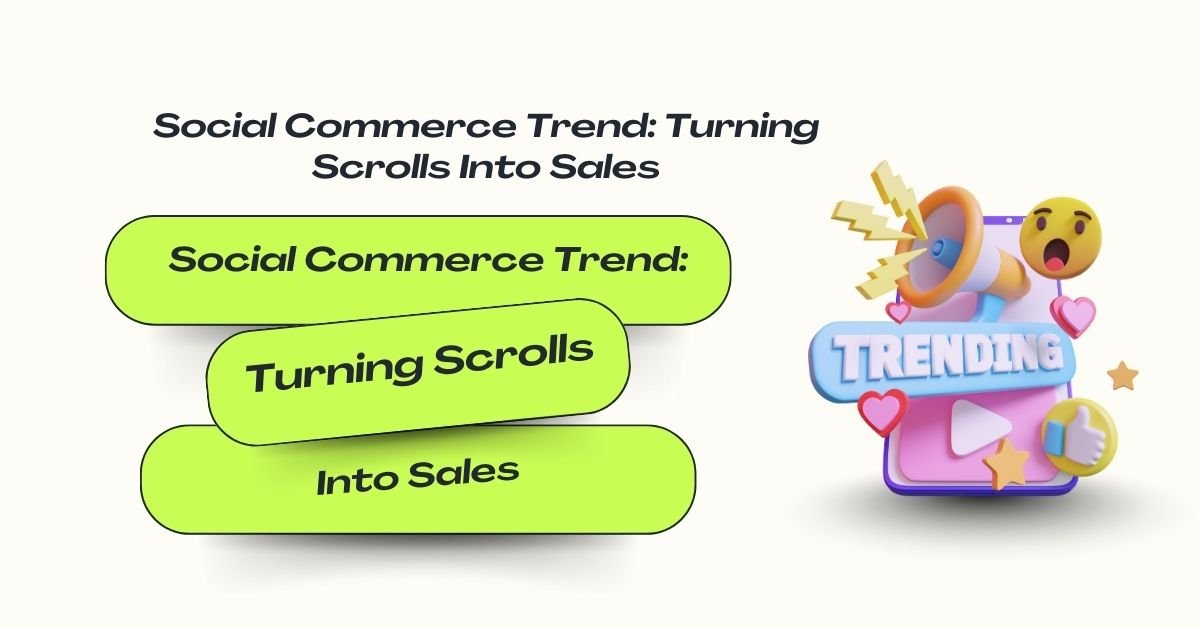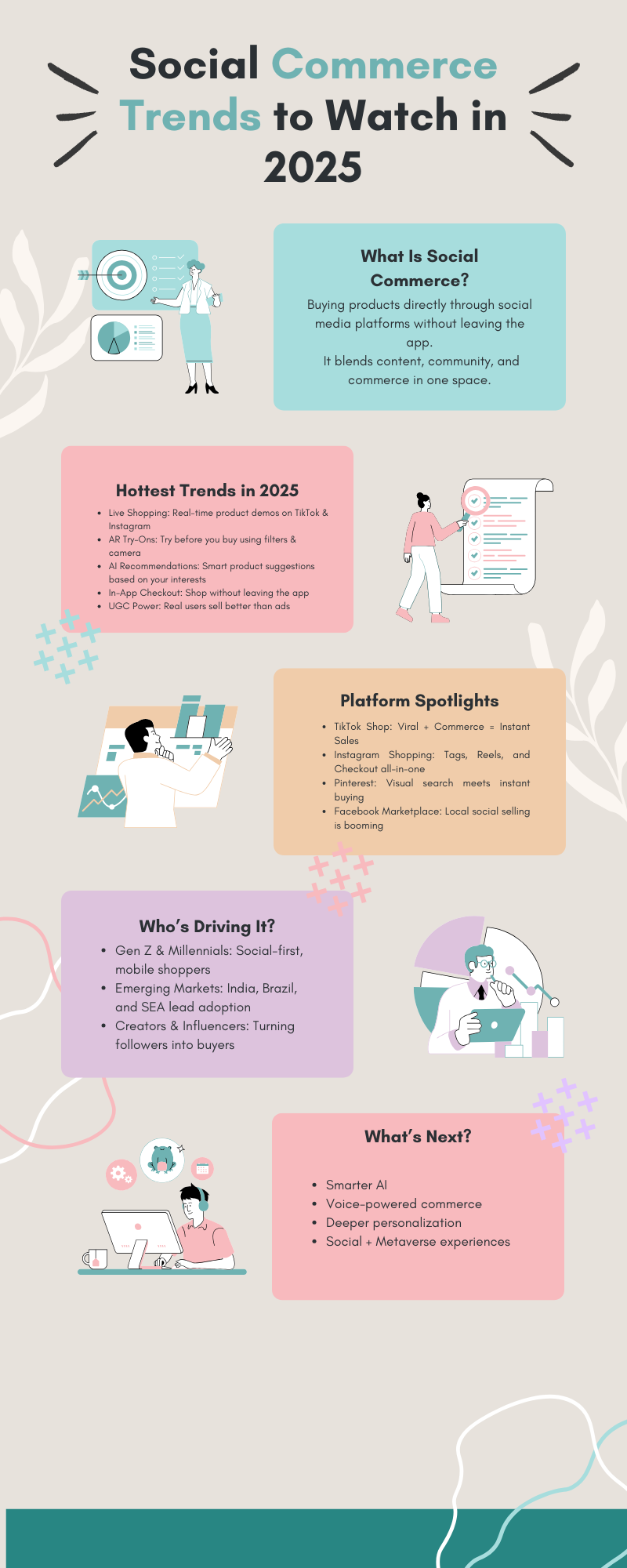
Social Commerce Trend: Turning Scrolls Into Sales
One of the most significant social commerce trends today is the way platforms facilitate instant buying from casual browsing. Consumers no longer just scroll for entertainment; they discover, evaluate, and purchase within the same feed. Instagram Shops, TikTok’s “Shop Now” feature, and Facebook Marketplace all facilitate seamless in-app checkout, making this possible. For brands, this means every post, reel, or story has sales potential. A short video showcasing a product can trigger impulse purchases within seconds. By blending entertainment with commerce, social media is transforming passive engagement into measurable revenue for businesses of all sizes.
What Is Social Commerce and Why It’s Booming in 2025
Social Commerce Trends is the next big thing in digital retail, combining online shopping with social media platforms. It’s more than just browsing products; it’s about making purchases directly through apps like Instagram, TikTok, and Facebook. With an increasing number of consumers spending hours on social media, brands have tapped into these platforms to create seamless shopping experiences.
Social commerce is booming due to the rise of interactive features and an evolving shopping culture. Consumers now seek instant gratification and prefer the ease of shopping where they already spend their time. Social media platforms have adapted, introducing live shopping events, shoppable posts, and influencer partnerships, making it easier than ever to make a purchase.
The growing integration of AI and data-driven tools ensures personalized experiences for users, making the entire process smoother. Social commerce is not just a trend but a powerful shift in how we shop today.
How Are Social Commerce Platforms Changing the Way We Shop?
- Social commerce has turned everyday scrolling into active shopping. The shift is not just about convenience; it’s about trust, personalization, and interaction. Today, platforms like Instagram, Facebook, TikTok, and Pinterest are redefining how buyers discover and purchase products. These changes are part of fast-evolving social commerce trends, which combine entertainment with transactions. Customers now see products in real-life contexts, engage with reviews instantly, and complete purchases without leaving the app. From livestream shopping to in-app checkouts, these innovations are making online shopping seamless and engaging, and brands worldwide are capitalizing on them to build stronger customer relationships.
1. Instagram: Turning Content into Commerce
Instagram has become the heartbeat of modern shopping. Through shoppable posts, reels, and stories, users can instantly buy products they see on their feed. The platform’s integration of AI-driven recommendations makes product discovery effortless, while influencer-led promotions add authenticity and credibility. This shift has made Instagram central to many social commerce trends, as consumers find it easy to transition from inspiration to purchase.
Tips for Brands:
- Use Instagram Shops to showcase products.
- Add shoppable tags to Reels and Stories.
- Collaborate with micro-influencers for authentic reach.
2. Facebook: Building Trust with Communities
Facebook pioneered the idea of connecting people and is now using that strength to drive purchases. Marketplaces, groups, and Facebook Shops enable users to browse and purchase within trusted circles. It plays a significant role in social commerce trends, especially for small businesses targeting local buyers. The ability to combine ads with organic group discussions makes Facebook a unique ecosystem for both discovery and conversion.
Key Points:
- Facebook Marketplace dominates local peer-to-peer sales.
- Shops feature enables seamless checkout without third-party sites.
- Community groups drive word-of-mouth trust for new products.
3. TikTok: Entertainment Meets Shopping
TikTok has revolutionized shopping by merging viral entertainment with commerce. The platform’s algorithm presents users with products naturally and engagingly. Viral challenges, hashtags, and influencer-led content push items into mainstream awareness overnight. These innovations make TikTok central to social commerce trends, where fun drives purchasing behavior. Its partnership with Shopify and in-app checkout features show how entertainment and commerce can co-exist seamlessly.
Facts:
- Over 50% of TikTok users say they’ve discovered new brands on the app.
- Viral product hashtags often generate millions of views within hours.
- TikTok LIVE shopping sessions mimic TV-style sales in real time.
4. Pinterest: Visual Discovery and Lifestyle Shopping
Pinterest has positioned itself as a discovery-first platform, ideal for lifestyle and niche shopping. Users come here for inspiration, whether it’s fashion, home décor, or DIY. Rich pins and shop tabs allow direct purchases, bridging the gap between browsing and buying. Pinterest significantly contributes to social commerce trends by blending discovery with action, particularly in categories such as fashion and interior design.
Tips for Businesses:
- Optimize pins with product details and keywords.
- Use “Shop the Look” pins to increase basket value.
- Target seasonal trends, as Pinterest search peaks during holidays.
5. WhatsApp: Conversational Commerce at Scale
WhatsApp has transformed into a powerful shopping tool, particularly in regions like India. With WhatsApp Business and catalog features, small businesses can showcase products and interact directly with customers. It supports secure payments via UPI, making the buying journey smooth. This peer-to-peer, trust-based system is a defining feature of modern social commerce trends, where conversations drive conversions.
Key Points:
- Direct, real-time interaction increases customer trust.
- Payment integrations make checkout effortless.
- Ideal for local and small businesses targeting mobile-first users.
6. YouTube: Long-Form Content Meets Direct Selling
YouTube integrates product placement with content, making it a powerful driver of purchase decisions. Product links under videos, livestream shopping, and influencer unboxings showcase items in context. YouTube’s role in social commerce trends is unique because it combines long-form storytelling with direct product discovery, offering a seamless experience for users.
Facts:
- Product review videos have a significant influence on purchase intent.
- Live shopping events combine entertainment with Q&A-driven buying.
- Integration with Shopify lets creators sell while streaming.
7. Snapchat: AR Shopping and Gen Z Influence
Snapchat places a strong emphasis on augmented reality, offering AR try-ons for fashion, beauty, and accessories. With its Gen Z user base, it thrives on blending fun interactions with shopping. Its AR lens features are central to social commerce trends, allowing users to virtually test products before making a purchase. It reduces return rates and enhances confidence in purchases.
Tips for Brands:
- Use AR lenses to create engaging shopping experiences.
- Focus campaigns on Gen Z trends, such as fashion and gaming.
- Leverage Snapchat Discover for brand storytelling.
8. Emerging Trends Across Platforms
The future of commerce will be shaped by the integration of AI, AR, and seamless checkout. Key social commerce trends include community-based group buying, influencer-led product drops, and sustainable shopping movements. Platforms have been created into full markets that are now solely utilised for entertainment or contact. By blending storytelling with shopping, they create experiences that feel less like advertising and more like personal recommendations.
Key Points:
- Social commerce is expected to grow into a $1.2 trillion industry by 2025.
- Group buying and live shopping are gaining traction globally.
- AI-powered personalization keeps users engaged longer and drives sales.
Top Social Commerce Trends You Can’t Ignore
Social Commerce Trends has rapidly evolved into a key driver of online sales, transforming how businesses and consumers interact on social media platforms. The integration of shopping features directly into social media apps has changed the game, making it easier for users to discover, engage with, and purchase products without leaving their favourite platforms. As a result, businesses are looking for innovative ways to leverage these trends to boost their visibility and sales. Here are some of the top social commerce trends you should be paying attention to:
1. Shoppable Content
Shoppable content has taken social commerce to the next level. Platforms like Instagram, Facebook, and Pinterest have introduced features that allow users to shop directly from posts, stories, and videos. By integrating clickable product tags, brands can make the shopping process seamless. Consumers no longer need to click out of the app to complete their purchase.
Pro: Shoppable content makes buying effortless, providing a smoother path from discovery to purchase.
Con: It requires high-quality visuals and regular content updates to remain effective.
2. Live Streaming Sales
Live streaming is quickly becoming a top way to connect with consumers in real-time. Platforms like Instagram Live, Facebook Live, and TikTok allow brands to showcase their products, answer questions, and engage with their audience while offering exclusive discounts or deals. This live interaction fosters a sense of urgency and personal connection, driving immediate purchases.
Pro: Live streams offer real-time interaction, creating a sense of urgency and fostering trust with consumers.
Con: Requires significant preparation and consistency to maintain a loyal viewership.
3. Social Proof and User-Generated Content
User-generated content (UGC) has been a game-changer in social commerce. Consumers trust content created by their peers more than branded content, and seeing real people use a product often sparks interest. Brands are increasingly leveraging UGC by reposting customer reviews, photos, and videos on their social channels. It not only helps build brand authenticity but also drives engagement.
Pro: UGC boosts trust and builds authenticity, leading to higher engagement rates and more conversions.
Con: It can be not easy to curate quality UGC and ensure it aligns with brand values.
4. Social Commerce with Augmented Reality (AR)
Augmented Reality (AR) is enhancing the online shopping experience by allowing consumers to try before they buy. Brands in beauty, fashion, and furniture are integrating AR to let customers visualize products on themselves or in their homes before making a purchase. For example, AR filters on Instagram let users try on makeup or sunglasses, offering a more interactive shopping experience.
Pro: AR makes the online shopping experience more immersive, helping customers feel more confident in their purchase decisions.
Con: It requires investment in AR technology and may not be suitable for every product category.
5. Social Commerce Marketplaces
Many platforms are expanding their marketplace offerings, with social media sites like Facebook, Instagram, and even TikTok launching in-app marketplaces. These platforms allow brands to create a full storefront experience, making it easy for users to browse, discover, and shop from a single platform. It creates a convenient, centralized shopping experience, reducing friction for consumers.
Pro: Social commerce marketplaces provide convenience, allowing users to shop directly within the app without leaving the platform.
Con: High competition from multiple sellers in a single marketplace can make it challenging to stand out.
6. Influencer Marketing
Influencer marketing continues to thrive in the world of social commerce. Collaborations between brands and influencers help build trust with audiences who value the recommendations of personalities they follow. Brands are shifting from traditional advertising to influencer-driven campaigns, allowing influencers to showcase products through stories, posts, and even live sessions.
Pro: Influencers bring credibility and reach, expanding the brand’s visibility to new, highly engaged audiences.
Con: Influencer partnerships can be expensive, and finding the right fit is crucial for success

Regional & Demographic Insights
Social Commerce Trends adoption is booming in emerging markets like India, Brazil, and Indonesia. These regions are mobile-first and heavily influenced by social media trends. With rising internet penetration and affordable smartphones, users are skipping traditional e-commerce and jumping straight into social shopping. Gen Z and millennials are driving this shift. They trust creators more than brands and prefer buying directly through Instagram, TikTok, and WhatsApp. For example, micro-influencers in India now launch full product lines through reels and live sessions. Brands that localize content and embrace platform-native behaviour are gaining massive traction across these fast-growing regions.
Social Commerce in Emerging Markets
Consumers in fast-developing regions like India, Southeast Asia, and Brazil are fueling social commerce. Social media and shopping now merge seamlessly, especially in India’s tier‑2 towns, thanks to apps like Meesho tapping WhatsApp networks. In Southeast Asia, live‑shopping and in‑app checkouts dominate mobile feeds. Small towns in India are seeing digital platforms such as eSamudaay grow, giving sellers tools to reach local customers online. These markets lead global social commerce growth, driven by affordable mobile data, digital payments, and a rising class of savvy shoppers.
Gen Z and Millennials as Primary Shoppers
Gen Z and Millennials are leading the social commerce wave. They scroll, shop, and share all within the same app. For them, Instagram, TikTok, and Pinterest aren’t just for content; they’re shopping hubs. These digital natives value convenience, quick purchases, and peer reviews. Influencer-driven posts, viral product trends, and user-generated videos often drive buying decisions.
A study shows that over 60% of Gen Z have bought something directly from social media. Brands that tap into their habits with authentic content, fast checkout, and personalized offers can turn followers into loyal buyers. Social shopping fits perfectly with their fast-paced lifestyle.
What Does the Future of Social Commerce Look Like?
The future of shopping is deeply tied to social commerce. Platforms like Instagram, TikTok, and Facebook are no longer just for sharing content; they are becoming complete marketplaces. Consumers today prefer to discover, review, and purchase products without leaving their favorite apps. This shift is driving new social commerce trends that will shape how brands connect with audiences in the coming years.
The popularity of shopping via livestream is one major increase. In China, it already accounts for billions in sales, and the same model is gaining traction in India and the U.S. Another significant development is the integration of AR try-ons, which allows shoppers to visualize products like sunglasses or furniture in real-time before making a purchase.
AI-driven personalization will also play a significant role. Brands will utilize data from social platforms to display users precisely what they want, thereby increasing conversion rates. At the same time, secure payment options and one-click checkouts will make transactions seamless and convenient.
Conclusion
Social commerce trends are reshaping how people discover and buy products in 2025. With live shopping, AR try-ons, and in-app checkout becoming the norm, brands can no longer afford to ignore these shifts. Platforms like TikTok, Instagram, and Pinterest are turning into full-fledged shopping hubs. Consumers want quick, personalized, and social-driven experiences. To stay ahead, businesses must blend content with commerce and build real connections with their audience. The future of social shopping is here, and those who adapt early will lead the market. Now is the time to rethink your strategy and embrace the power of social commerce.






Add Comment